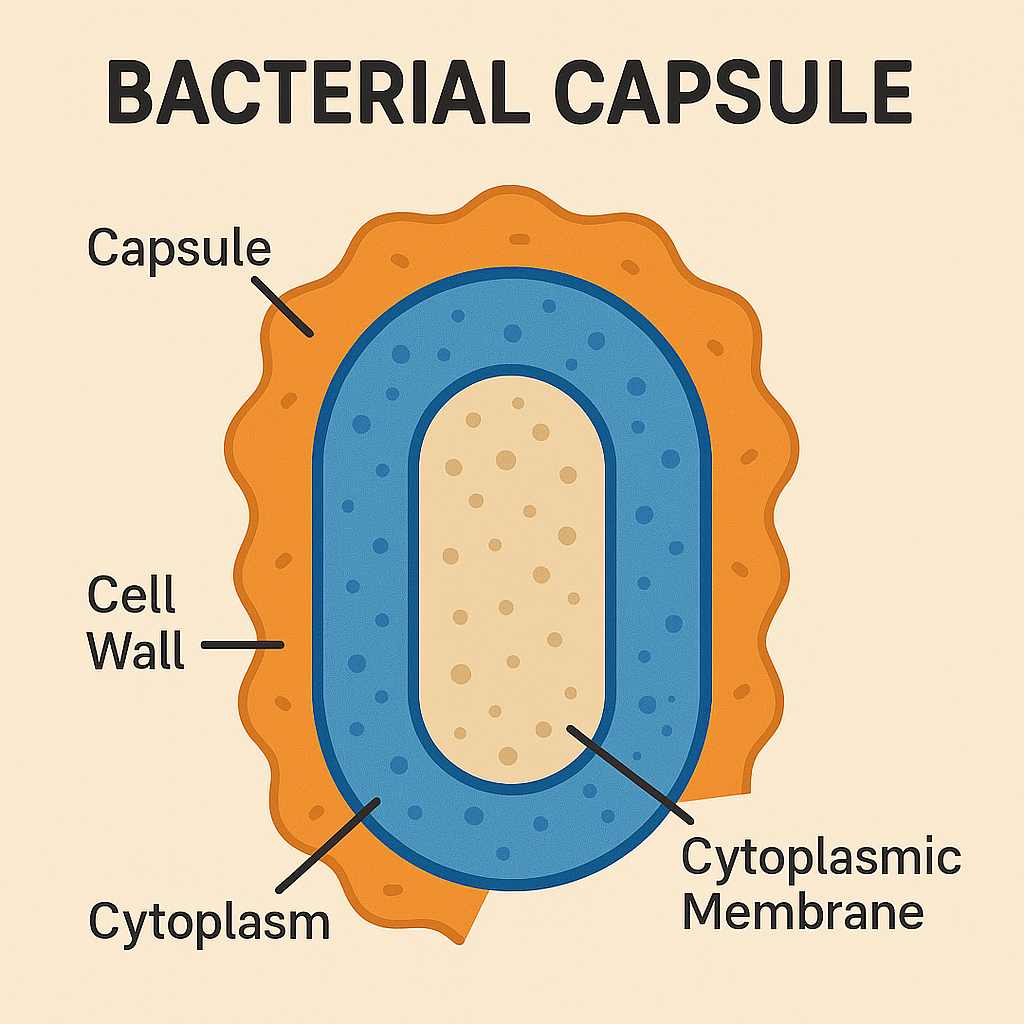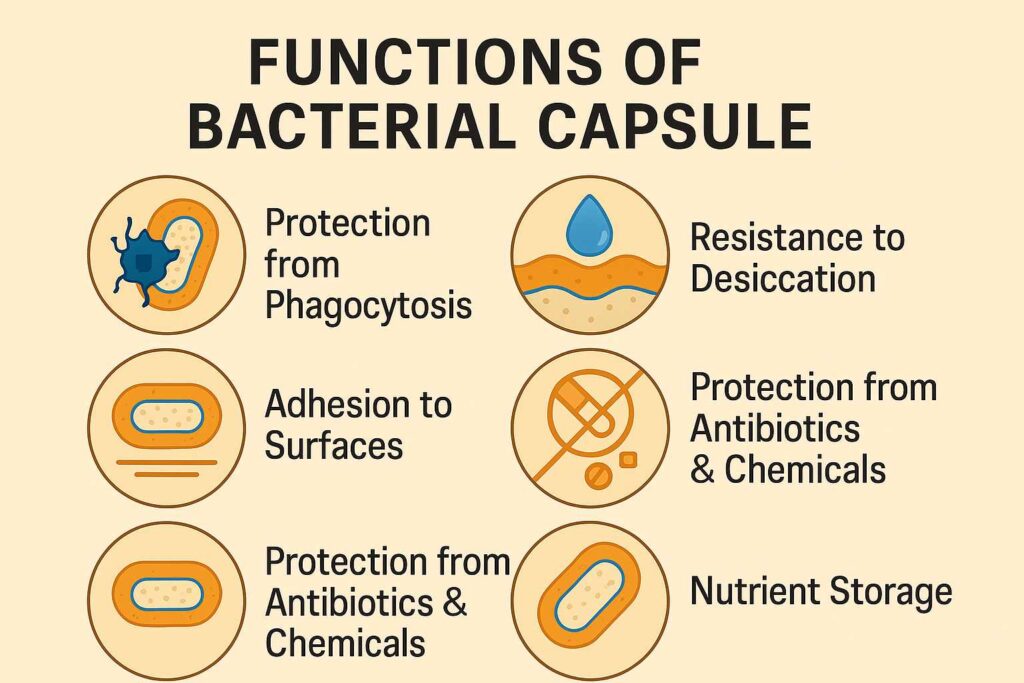Bacteria are tiny organisms that live almost everywhere on surfaces, in the soil, water, and even inside living things like humans and animals. While they are microscopic, they are incredibly diverse and have unique features that help them survive. One of the most important outer features in some bacteria is the capsule.
The bacterial capsule is a protective layer that surrounds the outer wall of certain bacteria. It plays a big role in protecting the bacteria, helping them survive, and sometimes making them more dangerous to humans and animals.
What is a Bacterial Capsule?
A bacterial capsule is a thick, sticky, gelatinous layer that lies outside the cell wall of some bacteria. It is not present in all bacteria, only in certain species. The capsule is made mainly of polysaccharides (sugar molecules), although in some bacteria it can also contain proteins.
The capsule is considered a part of the glycocalyx, which refers to any sticky outer layer made of sugars. The capsule is different from a slime layer, which is also a type of glycocalyx. The slime layer is looser and not as organized, while the capsule is well-organized, firmly attached to the cell, and much more structured. The bacterial capsule is mainly composed of polysaccharides (sugar chains), but in some bacteria like Bacillus anthracis, it is made of polypeptides (amino acid chains). It also contains a high amount of water, which helps protect the bacteria from drying out.
Bacterial capsule diagram

Summary of Bacterial Capsule
- A bacterial capsule is a thick, well-organized, and firmly attached outer layer made mainly of polysaccharides (or sometimes polypeptides), located outside the cell wall of certain bacteria.
- It protects bacteria from phagocytosis, desiccation, and antibiotics; helps in adhesion to surfaces; and increases bacterial virulence by helping them evade the immune system.
- Common capsulated bacteria include Streptococcus pneumoniae, Klebsiella pneumoniae, Haemophilus influenzae, and Bacillus anthracis, all known for causing serious human infections.
Table of Contents
Structure of Bacterial Capsule
Let’s look into the structure of the capsule more closely:
A. Composition
The capsule is mostly made of polysaccharides (complex sugars), but in some bacteria, it is made of polypeptides (chains of amino acids).
- Polysaccharide capsules: These are the most common. The exact sugars can vary depending on the bacterial species. Common sugars include glucose, galactose, rhamnose, and others.
- Polypeptide capsules: Less common, but found in some pathogenic bacteria like Bacillus anthracis (causes anthrax), which has a capsule made of poly-D-glutamic acid.
B. Appearance under Microscope
Capsules do not stain easily with regular dyes. To view them, special capsule staining techniques are used, like negative staining (e.g., using India ink or nigrosin). Under the microscope, the capsule appears as a clear halo around the bacterial cell.
C. Size and Thickness
Capsules vary in thickness and size. Some are very thin, while others are very thick and can be several times the size of the bacterial cell itself. The capsule’s size can also change depending on environmental conditions like temperature, nutrient availability, and moisture.
Functions of Bacterial Capsule

The capsule performs many important roles for the bacteria that possess it. These functions often give the bacteria an advantage in terms of survival, infection, and resistance. The key functions are:
A. Protection Against Phagocytosis
One of the most important functions of the capsule is protecting the bacteria from phagocytosis. Phagocytosis is a process where immune cells (like macrophages and neutrophils) engulf and destroy bacteria. Capsules make it difficult for these immune cells to grab onto the bacteria and engulf them.
This means that capsulated bacteria are often more virulent (more likely to cause disease) than non-capsulated ones.
B. Protection from Desiccation (Drying Out)
Capsules are made of water-loving (hydrophilic) substances. They help the bacteria retain moisture and prevent them from drying out, which is important for survival in dry environments.
C. Adherence to Surfaces
Capsules help bacteria stick to surfaces. This is especially useful for bacteria that infect the human body because it allows them to attach to tissues like the throat, lungs, or intestines. It also helps in forming biofilms colonies of bacteria stuck to a surface (like dental plaque on teeth).
D. Protection from Antibacterial Agents
Capsules can protect bacteria from being killed by certain antibiotics or toxic substances. Some capsules block the entry of drugs or chemicals, while others help in forming biofilms that are harder for drugs to penetrate.
E. Nutrient Storage
In some cases, the capsule can store nutrients and serve as a reserve food source, especially in nutrient-poor environments.
F. Role in Immune Evasion
Capsules can hide antigens on the bacterial surface, making it harder for the immune system to recognize and attack them. Some capsules mimic host tissues, like the hyaluronic acid capsule of Streptococcus pyogenes, which resembles human connective tissue.
Types of Glycocalyx: Capsule vs. Slime Layer

Although we’re mainly discussing the capsule, it’s useful to understand how it differs from the slime layer, as both are types of glycocalyx.
| Feature | Capsule | Slime Layer |
|---|---|---|
| Attachment | Firmly attached to cell wall | Loosely attached |
| Structure | Well-organized | Unorganized |
| Visibility | Seen clearly under microscope | Harder to see |
| Function | Protection, virulence | Mostly helps in attachment |
Examples of Capsulated Bacteria
Here are some of the most well-known bacteria that have capsules. Many of them are pathogenic, meaning they can cause diseases.
A. Streptococcus pneumoniae
- Capsule Type: Polysaccharide
- Disease: Pneumonia, meningitis, sinusitis
- Notes: The capsule is a major virulence factor. There are over 90 different capsule types (serotypes).
B. Klebsiella pneumoniae
- Capsule Type: Polysaccharide
- Disease: Pneumonia, urinary tract infections, bloodstream infections
- Notes: The capsule gives colonies a shiny, mucoid appearance on culture plates.
C. Haemophilus influenzae (type b)
- Capsule Type: Polyribosylribitol phosphate (PRP)
- Disease: Meningitis, epiglottitis, pneumonia in children
- Notes: The type b capsule is especially dangerous; vaccines target this capsule.
D. Bacillus anthracis
- Capsule Type: Polypeptide (poly-D-glutamic acid)
- Disease: Anthrax
- Notes: One of the few bacteria with a protein capsule; critical for immune evasion.
E. Neisseria meningitidis
- Capsule Type: Polysaccharide
- Disease: Meningitis, sepsis
- Notes: Vaccines are developed based on the capsule types (A, B, C, Y, W-135).
F. Yersinia pestis
- Capsule Type: Protein capsule (F1 antigen)
- Disease: Plague
- Notes: The capsule helps the bacteria avoid being phagocytosed by immune cells.
G. Escherichia coli (some strains)
- Capsule Type: Polysaccharide (e.g., K1 antigen)
- Disease: Neonatal meningitis, urinary tract infections
- Notes: The K1 capsule is similar to human brain tissue, which helps in immune evasion.
Medical Importance of Bacterial Capsules
The presence of a capsule has significant medical implications. Here’s why:
A. Vaccine Development
Capsules are often used to make vaccines. For example:
- The pneumococcal vaccine (against Streptococcus pneumoniae)
- The Hib vaccine (against Haemophilus influenzae type b)
- The meningococcal vaccine (against Neisseria meningitidis)
These vaccines work by teaching the immune system to recognize and fight off the bacterial capsule.
B. Diagnosis of Infections
Capsules can be detected in lab tests to help identify the bacteria. Capsule staining, serological tests, and antigen detection are useful tools.
C. Treatment Challenges
Capsulated bacteria are often harder to treat because the capsule can resist antibiotics and immune attack. They may also form biofilms that make infections chronic and difficult to eliminate.
Laboratory Identification of Capsules
In microbiology labs, capsules are identified using various techniques:
A. Capsule Staining
- Negative staining with India ink or nigrosin creates a dark background, while the capsule remains unstained, forming a clear halo.
- Special capsule stains like Anthony’s stain may also be used.
B. Serological Methods
Quellung reaction: When specific antibodies bind to the capsule, it becomes visible under a microscope. This test is used for identifying Streptococcus pneumoniae.
C. Culture Characteristics
Some capsulated bacteria produce mucoid colonies on agar plates due to their capsule.
Conclusion
The bacterial capsule is a fascinating and critical structure that gives certain bacteria a survival advantage, especially in hostile environments like the human body. Its role in protecting bacteria from the immune system and antibiotics makes it an important factor in disease development. Understanding the capsule helps scientists and doctors design better vaccines, treatments, and diagnostic tools.
While not all bacteria have capsules, those that do often use them as powerful weapons. That’s why studying bacterial capsules is so important in microbiology, medicine, and biotechnology.
Frequently Asked Questions
What is capsule in bacterial cell?
A bacterial capsule is a protective outer layer made of polysaccharides or proteins that helps bacteria avoid immune attacks and stick to surfaces. It also keeps bacteria from drying out and makes them more resistant to antibiotics and harsh environments. Think of it as a shield that helps bacteria survive and spread!
What is bacterial capsule made of ?
A bacterial capsule is mostly made of polysaccharides (sugar molecules) or proteins that form a protective coating around the bacteria. This slimy layer helps bacteria stay hydrated, avoid immune attacks, and stick to surfaces. Think of it as a flexible shield that helps bacteria survive in tough environments!
What is bacterial capsule is chemically composed of ?
The bacterial capsule is mainly composed of polysaccharides (sugar chains), but in some bacteria like Bacillus anthracis, it is made of polypeptides (amino acid chains). It also contains a high amount of water, which helps protect the bacteria from drying out.
Related Articles

